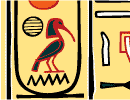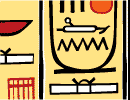Our first venture into the area was in 1987, when Warsaw University's
Polish Center for Mediterranean Archaeology conducted a geophysical survey
and sank three trial pits, each about five meters (16.4 feet) on a side.
That preliminary examination proved that the desert adjoining the west
side of Djoser's pyramid enclosure is full of burials. We found deep
shafts hewn in the rock and many mummies, some of them wrapped in a kind
of gypsum cover with a decorated surface. Other mummies were encased only
in simple coffins of wood or clay. This part of the Memphis necropolis was
used for almost 4,000 years, from the Archaic Period (beginning in the
third millennium B.C.) up to the Byzantine Period that ended with the Arab
conquest of A.D. 641.
A test pit about 100 meters (328 feet) west of the enclosure revealed a
wall running parallel to the pyramid. The wall's primitive construction
and the objects found beside it were diagnostic of the earliest period of
Pharaonic Egypt. Erected on a leveled rock surface, the wall seemed to be
part of a monumental tomb. Who could have qualified for such an important
burial place, just in front of the oldest pyramid, we wondered.
As soon as we could return to Egypt, in 1996, as part of a joint
Polish-Egyptian expedition with the Supreme Council for Egyptian
Antiquities, we began expanding this excavation. From that point, one
surprise followed another.
We unearthed the courtyard of the tomb, discovering a leveled rock
surface covered with a thick layer of mud, in which small bits of bone and
circular red and black smudges bore witness to ritual fires that were part
of the cult of the dead.
Looking for the entrance to subterranean parts of the tomb, we had to
work eastward toward the pyramid. This was a time-consuming task, however,
for the tomb is covered by sand and debris that contain many simple
burials from the Ptolemaic and Roman Periods (the last few centuries B.C.
through the first centuries A.D.). These mummies and coffins require
painstaking treatment: They must be cleaned carefully, recorded,
conserved, and removed immediately, before the sudden change of
environment starts destroying them.
A Colorful Riddle
When we finally removed mud-brick rubble from atop the wall, we saw
splendid colors on reliefs decorating the entrance to a funerary chapel
hewn in the rock. The carved mural showed the tomb's owner in the company
of a lady. We read his name on the entrance, Meref-nebef ("The one who
loves his lord"), and that of his consort, Meres-ankh ("The one who loves
life").
Meres-ankh's role became more complicated as we later discovered the
images of five other women, all of them described as the wives of
Meref-nebef, whose "beautiful name" was listed as Fefi. Meres-ankh appears
on the murals without any title. Was she, perhaps, an intern at the court
of Fefi? Even by ancient Egypt's quite liberal standards, this
circumstance seems exceptional. Whatever the function of this mysterious
woman, we knew we were not dealing with some boring and banal bureaucrat.
Reaching the vizier's tomb required clearing away mud bricks stacked
over a layer of irregular stones, which reached to the bottom of two
shallow shafts in the rock. A wall between the shafts led toward the
pyramid. What was hidden behind this curtain of stones and bricks? This
riddle was to challenge our patience, as we had to wait a year, until
September 1997, to get through the upper layers.
When we finally reached the rock behind the curtain, we found ourselves
standing in front of a rock-hewn mastaba from Old Kingdom times. The first
hieroglyphs, sculpted in sunk relief, appeared on the stone facade of a
funerary chapel.
Behind the last layer of debris, we read the three names and
ostentatious titles of the tomb's owner sculpted at the top of the facade.
Besides Meref-nebef and Fefi, he had yet another "great name:" Unis-ankh.
The names helped us put a tentative date on the tomb: The great name
contains the sobriquet of Unis, the last pharaoh of the Fifth Dynasty
(circa 2494-2345 B.C.), and Fefi is a typical name of the early Sixth
Dynasty, when such short monikers as Teti or Pepi were popular with kings.
At the top of the long list of Fefi's honorific and priestly titles is
the one that puts him at the very top of Egyptian hierarchy. He was a
vizier early in the progressive disintegration of Egyptian society. The
social repercussions of this turbulent time may be recorded in tombs of
high officials. In some tombs, representations of certain family members
and large parts of hieroglyphic inscriptions appear to have been
obliterated by political opponents. The tomb of Meref-nebef did not escape
such a fate.
In the reliefs and paintings decorating the walls of his funerary
chapel, images of some of his sons - except for one - were destroyed. The
only son whose figures remain intact bears his father's name: Fefi. Did he
destroy the figures of his brothers? What were the motives: politics,
religion, or just internal quarrels among the vizier's descendants,
perhaps sons of various wives? We may never learn the answer.
Tall Tales of Sainthood
The facade itself is a masterpiece of sophisticated composition and
reveals the propagandist character of Egyptian art. Above the entrance is
an "ideal biography" of Fefi. This inscription describes our vizier almost
as a saint. Its hieroglyphic signs and blue-green color imitate
hieroglyphs in the "Texts of Pyramids" engraved inside royal pyramids of
the same period.
Contrasting with this is a "testament" of the vizier on both sides of
the narrow entrance. This long text, in raised relief, is painted in vivid
colors against a blue-gray background.
Eight images of the vizier, showing him walking proudly toward the
entrance of the chapel, complete this lavishly decorated portal. Inside
the extremely narrow doorway (60 centimeters, or 23.5 inches), are
splendidly preserved color reliefs decorating the walls of the chapel.
This relatively small room seems to be a kaleidoscope of the most
beautiful scenes known from Old Kingdom tombs. Colors this vivid and
vibrant have been discovered in no other tomb of the period. The vizier
usually appears in the company of one or more of his wives and, in the
chapel, four of them are depicted as an orchestra of harpists.
Some of these reliefs, however, are badly damaged, and not all the
destruction was intentional. The extremely fragile structure of the local
limestone causes salts to concentrate on the paintings. This poses a
challenge to our conservators from the National Museums in Warsaw and
Krakow. Conservation will take years of hard work.
Where's the Body?
Where is Fefi's mummy? If it still exists, it should rest in a stone
coffin at the bottom of a shaft inside or in front of the funerary chapel.
Searching for that shaft is a prime task for our next campaign. We hope
ancient robbers did not plunder it, as they did more than 20 deep burial
shafts that we recently unearthed between Fefi's tomb and Djoser's
pyramid.
Since grave robbers were mainly interested in gold, we could still find
some "false-door" stelae - stone slabs preserving names, titles, and
representations of the people who were buried there. Ancient Egyptians
believed it was through these "doors" that the soul of the deceased could
contact this world, mainly to collect food offerings left by priests in
front of such a stela.
Inscriptions found in some burial shafts we excavated record other
high-ranking courtiers, including a priestess described as a "King's sole
adornment."
We plan to extend the excavation this fall all the way to the enclosure
of Djoser's pyramid and perhaps discover who was the closest neighbor of
this great king in the other world.
Karol MySliwiec is Director of the joint Polish-Egyptian mission to
Saqqara and a Professor at the Polish Academy of Sciences' Research Center
for Mediterranean Archaeology at Warsaw University's Institute of
Archaeology. To help support this project, contact Dr. Myswliwiec at the
Polish Academy of Sciences, Palac Staszica Nowy Swiat 72, Room 33, 00-330
Warsaw, Poland.





